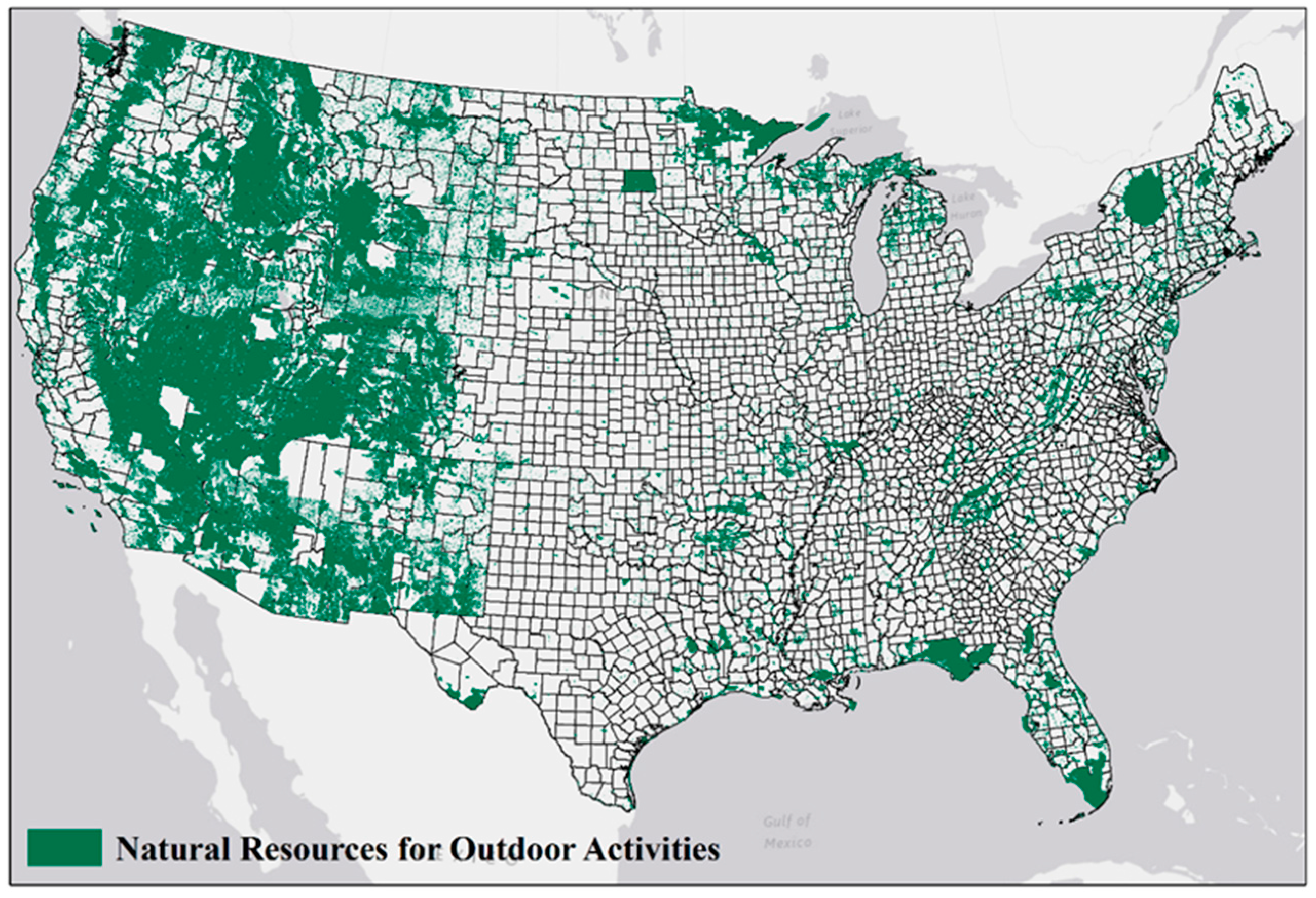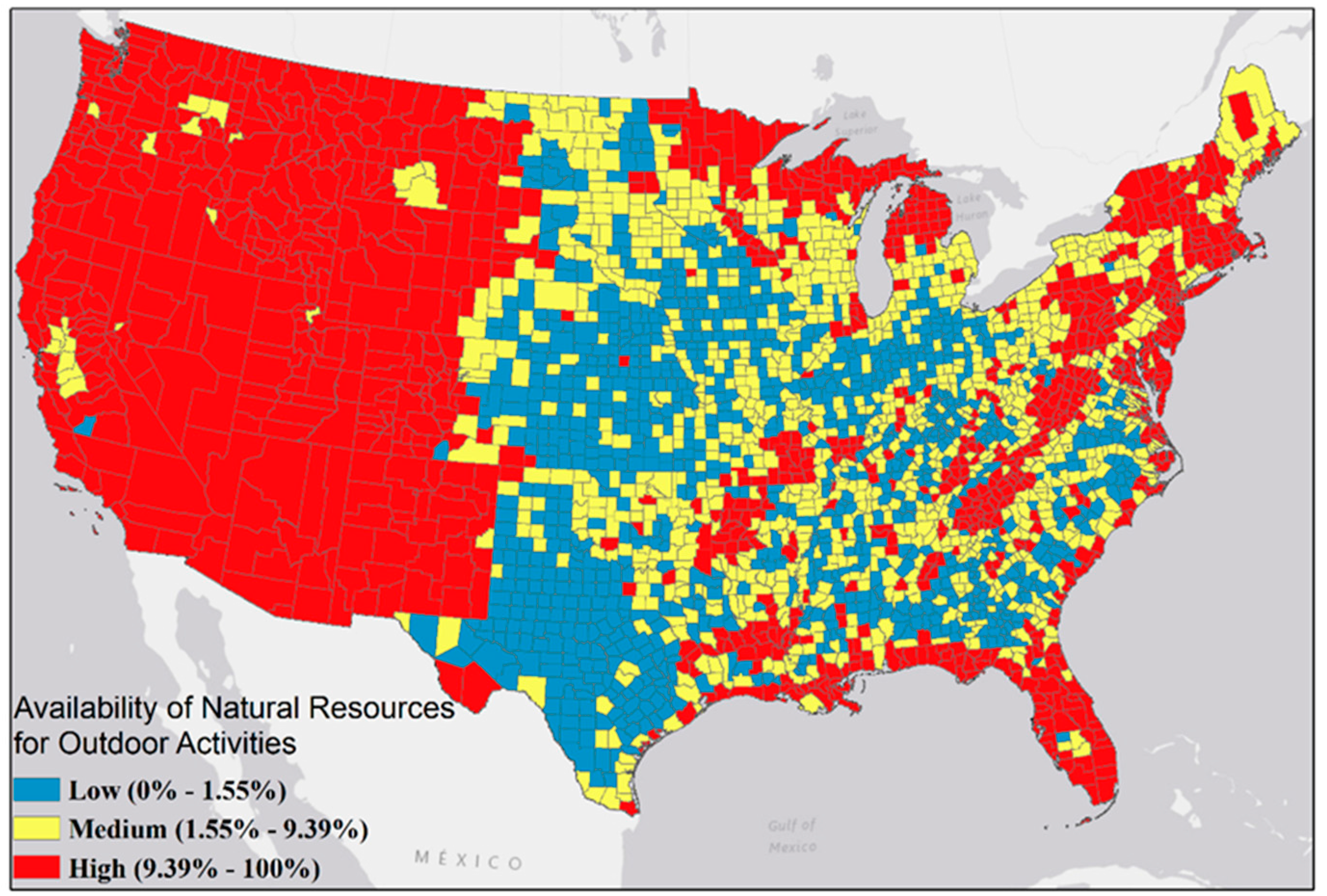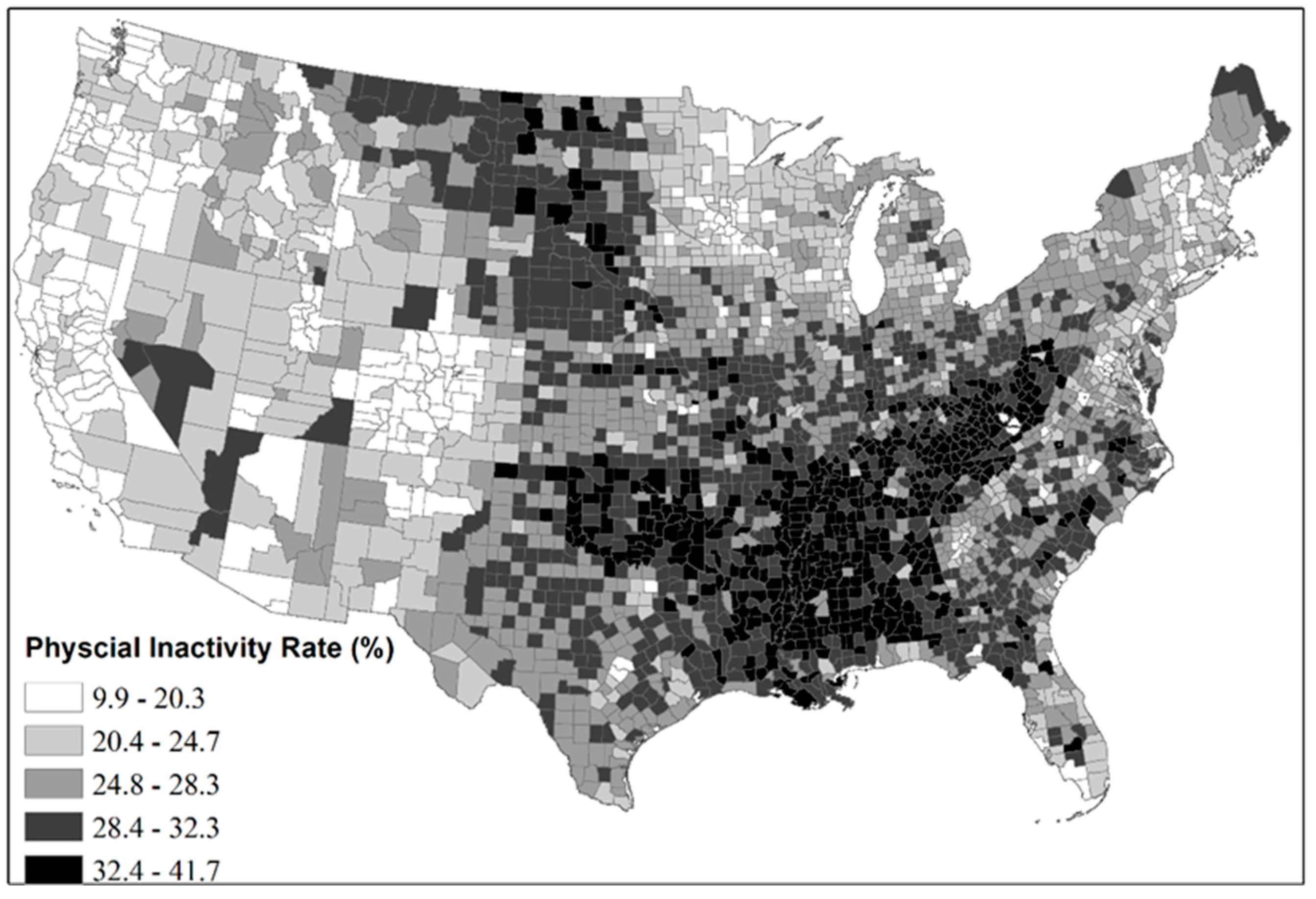Association between Natural Resources for Outdoor Activities and Physical Inactivity: Results from the Contiguous United States
Abstract
:1. Introduction
2. Materials and Methods
2.1. Definition and Estimation of Available Natural Resources for Outdoor Activities
2.2. Health and Socioeconomic Data
2.3. Statistical Analysis and Modeling
3. Results
4. Discussion
5. Conclusions
Acknowledgments
Author Contributions
Conflicts of Interest
References
- World Health Organization (WHO). Physical Inactivity: A Global Public Health Problem; World Health Organization: Geneva, Switzerland, 2011. [Google Scholar]
- Lee, I.M.; Shiroma, E.J.; Lobelo, F.; Puska, P.; Blair, S.N.; Katzmarzyk, P.T. Effect of physical inactivity on major non-communicable diseases worldwide: An analysis of burden of disease and life expectancy. Lancet 2012, 380, 219–229. [Google Scholar] [CrossRef]
- Hallal, P.C.; Andersen, L.B.; Bull, F.C.; Guthold, R.; Haskell, W.; Ekelund, U.; Lancet Physical Activity Series Working Group. Global physical activity levels: Surveillance progress, pitfalls, and prospects. Lancet 2012, 380, 247–257. [Google Scholar] [CrossRef]
- World Health Organization (WHO). Burden: Mortality, morbidity and risk factors. In Global Status Report on Noncommunicable Diseases; WHO: Geneva, Switzerland, 2010; Available online: http://www.who.int/nmh/publications/ncd_report_chapter1.pdf (accessed on 10 August 2016).
- Hallal, P.C.; Martins, R.C.; Ramírez, A. The Lancet Physical Activity Observatory: Promoting physical activity worldwide. Lancet 2014, 384, 471–472. [Google Scholar] [CrossRef]
- Maas, J.; Verheij, R.A.; Groenewegen, P.P.; De Vries, S.; Spreeuwenberg, P. Green space, urbanity, and health: How strong is the relation? J. Epidemiol. Commun. Health 2006, 60, 587–592. [Google Scholar] [CrossRef] [PubMed]
- Potwarka, L.R.; Kaczynski, A.T.; Flack, A.L. Places to play: Association of park space and facilities with healthy weight status among children. J. Commun. Health 2008, 33, 344–350. [Google Scholar] [CrossRef] [PubMed]
- Cohen, D.; Sehgal, A.; Williamson, S.; Sturm, R.; McKenzie, T.L.; Lara, R.; Lurie, N. Park use and physical activity in a sample of public parks in the city of Los Angeles. In RAND Technical Report; RAND: Santa Monica, CA, USA, 2006. [Google Scholar]
- Coutts, C.; Chapin, T.; Horner, M.; Taylor, C. County-level effects of green space access on physical activity. J. Phys. Activ. Health 2013, 10, 232–240. [Google Scholar] [CrossRef]
- Saveliev, A.A.; Mukharamova, S.S.; Chizhikova, N.A.; Budgey, R.; Zuur, A.F. Spatially continuous data analysis and modelling. In Analysing Ecological Data 2007; Springer: New York, NY, USA, 2007. [Google Scholar]
- LeSage, J.P.; Pace, R.K. Introduction to Spatial Econometrics; Taylor Francis: Boca Raton, FL, USA, 2009. [Google Scholar]
- Anselin, L. Under the hood: Issues in the specification and interpretation of spatial regression models. Agric. Econ. 2002, 27, 247–267. [Google Scholar] [CrossRef]
- Okwi, P.O.; Ndenge, G.; Kristjanson, P.; Arunga, M.; Notenbaert, A.; Omolo, A.; Henninger, N.; Benson, T.; Kariuki, P.; Owuor, J. Spatial determinants of poverty in rural Kenya. Proc. Natl. Acad. Sci. USA 2007, 104, 16769–16774. [Google Scholar] [CrossRef] [PubMed]
- Ogden, C.L.; Carroll, M.D.; Kit, B.K.; Flegal, K.M. Prevalence of obesity and trends in body mass index among US children and adolescents, 1999–2010. JAMA 2012, 307, 483–490. [Google Scholar] [CrossRef] [PubMed]
- Bauman, A.E.; Reis, R.S.; Sallis, J.F.; Wells, J.C.; Loos, R.J.; Martin, B.W.; Lancet Physical Activity Series Working Group. Correlates of physical activity: Why are some people physically active and others not? Lancet 2012, 380, 258–271. [Google Scholar] [CrossRef]
- Centers for Disease Control and Prevention (CDC). Facts about Physical Activity. CDC Behavioral Risk Factor Surveillance System. Available online: http://www.cdc.gov/physicalactivity/data/facts.html (accessed on 10 August 2016).
- Day, K. Active living and social justice: Planning for physical activity in low-income, black, and Latino communities. JAPA 2006, 72, 88–99. [Google Scholar] [CrossRef]
- Mitchell, R.; Popham, F. Effect of exposure to natural environment on health inequalities: An observational population study. Lancet 2008, 372, 1655–1660. [Google Scholar] [CrossRef]
- US Geological Survey (USGS) and Gap Analysis Program (GAP). Protected Areas Database of the United States (PADUS). 2012. Available online: http://gapanalysis.usgs.gov/padus/data/download/ (accessed on 1 October 2014). [Google Scholar]
- ATTAINSGEO. WATERS Geospatial Data Downloads. Available online: http://water.epa.gov/scitech/datait/tools/waters/data/downloads.cfm#305(b) (assessed on 1 September 2014).
- Environmental Systems Research Institute. ESRI ArcGIS Desktop: Release 10; Environmental Systems Research Institute: Redlands, CA, USA, 2014. [Google Scholar]
- World Health Organization (WHO). Factsheet of Physical Activity. 2016. Available online: http://www.who.int/mediacentre/factsheets/fs385/en/ (accessed on 10 August 2016).
- CDC. CDC Behavioral Risk Factor Surveillance System. Available online: http://www.cdc.gov/physicalactivity/data/facts.html (accessed on 1 August 2014).
- Bureau of the Census, US Department of Commerce. Poverty Areas. Bureau of the Census: Washington, DC, USA. Available online: http://www.census.gov/hhes/www/poverty/data/threshld/ (accessed on 1 January 2015).
- Anselin, L.; Rey, S. The Performance of Tests for Spatial Dependence in a Linear Regression; Report, 91–13; National Center for Geographic Information and Analysis, University of California Santa Barbara: Santa Barbara, CA, USA, 1991. [Google Scholar]
- Anselin, L.; Syabri, I.; Kho, Y. GeoDa: An introduction to spatial data analysis. Geogr. Anal. 2006, 38, 5–22. [Google Scholar] [CrossRef]
- Ward, M.D.; Gleditsch, K.S. Spatial Regression Models; Sage: Thousand Oaks, CA, USA, 2008; Volume 155. [Google Scholar]
- R Core Team. R: A Language and Environment for Statistical Computing; R Foundation for Statistical Computing: Vienna, Austria, 2013; Available online: http://www.R-project.org/ (accessed on 10 August 2016).
- Dark, S.J. The biogeography of invasive alien plants in California: An application of GIS and spatial regression analysis. Divers. Distrib. 2004, 10, 1–9. [Google Scholar] [CrossRef]
- Kissling, W.D.; Carl, G. Spatial autocorrelation and the selection of simultaneous autoregressive models. Glob. Ecol. Biogeogr. 2008, 17, 59–71. [Google Scholar] [CrossRef]
- Kim, C.W.; Phipps, T.T.; Anselin, L. Measuring the benefits of air quality improvement: A spatial hedonic approach. J. Environ. Econ. Manag. 2003, 45, 24–39. [Google Scholar] [CrossRef]
- Blanck, H.M.; Allen, D.; Bashir, Z.; Gordon, N.; Goodman, A.; Merriam, D.; Rutt, C. Let’s go to the park today: The role of parks in obesity prevention and improving the public’s health. Child. Obes. 2012, 8, 423–428. [Google Scholar] [CrossRef] [PubMed]
- Bratman, G.N.; Hamilton, J.P.; Hahn, K.S.; Daily, G.C.; Gross, J.J. Nature experience reduces rumination and subgenual prefrontal cortex activation. Proc. Natl. Acad. Sci. USA 2015, 112, 8567–8572. [Google Scholar] [CrossRef] [PubMed]
- Stigsdotter, U.K.; Ekholm, O.; Schipperijn, J.; Toftager, M.; Kamper-Jørgensen, F.; Randrup, T.B. Health promoting outdoor environments—Associations between green space, and health, health-related quality of life and stress based on a Danish national representative survey. Scand. J. Public Health 2010, 38, 411–417. [Google Scholar] [CrossRef] [PubMed]
- Swanwick, C.; Dunnett, N.; Woolley, H. Nature, role and value of green space in towns and cities: An overview. Built Environ. 2003, 29, 94–106. [Google Scholar] [CrossRef]
- Kaplan, S. The restorative benefits of nature: Toward an integrative framework. J. Environ. Psychol. 1995, 15, 169–182. [Google Scholar] [CrossRef]
- De Vries, S.; Verheij, R.A.; Groenewegen, P.P.; Spreeuwenberg, P. Natural environments-healthy environments? An exploratory analysis of the relationship between greenspace and health. Environ. Plan. 2003, 35, 1717–1732. [Google Scholar] [CrossRef]
- Radeloff, V.C.; Stewart, S.I.; Hawbaker, T.J.; Gimmi, U.; Pidgeon, A.M.; Flather, C.H.; Hammer, R.B.; Helmers, D.P. Housing growth in and near United States protected areas limits their conservation value. Proc. Natl. Acad. Sci. USA 2010, 107, 940–945. [Google Scholar] [CrossRef] [PubMed]
- Rasker, R. West Is Best How Public Lands in the West Create a Competitive Economic Advantage; Headwaters Economics: Bozeman, MT, USA, 2012. [Google Scholar]
- Delaware Valley Regional Planning Commission (DVRPC). Return on Environment: The Economic Value of Protected Open Space in Southeastern Pennsylvania; DVRPC: Philadelphia, PA, USA, 2011. [Google Scholar]
- Headwaters Economics. Economists Urge President Obama to Protect Federal Lands. 2011. Available online: http://headwaterseconomics.org/land/economists-president-public-lands/ (accessed on 1 March 2015).
- Oakes, J.M. The (mis) estimation of neighborhood effects: Causal inference for a practicable social epidemiology. Soc. Sci. Med. 2004, 58, 1929–1952. [Google Scholar] [CrossRef] [PubMed]
- Berrigan, D.; Tatalovich, Z.; Pickle, L.W.; Ewing, R.; Ballard-Barbash, R. Urban sprawl, obesity, and cancer mortality in the United States: Cross-sectional analysis and methodological challenges. Int. J. Health Geogr. 2014, 13, 1. [Google Scholar] [CrossRef] [PubMed]
- Howden, L.M.; Meyer, J.A. Age and Sex Composition: 2010; Census Briefs; US Department of Commerce, Economics and Statistics Administration and US Census Bureau: Washington, DC, USA, 2010.




| Model | Variable | Coefficients (β) | Pseudo-R2 | Moran’s I Score | Log Likelihood | AIC * | BIC * |
|---|---|---|---|---|---|---|---|
| OLS | Constant | 27.71 | 0.16 | 0.65 | –9024.8 | 18,053.7 | 18,065.7 |
| ANROA | –0.09 | ||||||
| SL I ** | Constant | 5.98 | |||||
| ANROA | –0.02 | ||||||
| ρ * of inactivity rate | 0.79 | 0.69 | –0.059 | –7720.5 | 15,447.0 | 15,465.2 | |
| SL II ** | Constant | 4.54 | |||||
| ANROA | –0.03 | ||||||
| %low-income household | 0.14 | 0.73 | –0.0017 | –7433.2 | 14,874.4 | 14,898.6 | |
| ρ * of inactivity rate | 0.64 |
| Factors | p-Values |
|---|---|
| Main effect: ANROA | <<0.001 |
| Main effect: Household Income | <<0.001 |
| Interaction Effect: ANROA & Household | 0.0039 |
© 2016 by the authors; licensee MDPI, Basel, Switzerland. This article is an open access article distributed under the terms and conditions of the Creative Commons Attribution (CC-BY) license (http://creativecommons.org/licenses/by/4.0/).
Share and Cite
Jiang, Y.; Yuan, Y.; Neale, A.; Jackson, L.; Mehaffey, M. Association between Natural Resources for Outdoor Activities and Physical Inactivity: Results from the Contiguous United States. Int. J. Environ. Res. Public Health 2016, 13, 830. https://doi.org/10.3390/ijerph13080830
Jiang Y, Yuan Y, Neale A, Jackson L, Mehaffey M. Association between Natural Resources for Outdoor Activities and Physical Inactivity: Results from the Contiguous United States. International Journal of Environmental Research and Public Health. 2016; 13(8):830. https://doi.org/10.3390/ijerph13080830
Chicago/Turabian StyleJiang, Yan, Yongping Yuan, Anne Neale, Laura Jackson, and Megan Mehaffey. 2016. "Association between Natural Resources for Outdoor Activities and Physical Inactivity: Results from the Contiguous United States" International Journal of Environmental Research and Public Health 13, no. 8: 830. https://doi.org/10.3390/ijerph13080830
APA StyleJiang, Y., Yuan, Y., Neale, A., Jackson, L., & Mehaffey, M. (2016). Association between Natural Resources for Outdoor Activities and Physical Inactivity: Results from the Contiguous United States. International Journal of Environmental Research and Public Health, 13(8), 830. https://doi.org/10.3390/ijerph13080830








